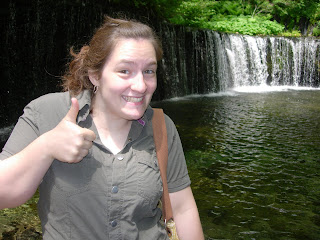Yesterday
Technos gave us the warmest welcome to their campus possible. To say that we were treated like rock stars is no exaggeration. After our red carpet debut (again, no hyperbole here --there really was a red carpet, and throngs of cheering Technos students!), we had a lovely welcoming party, tours of the and, for the faculty, a more intimate introduction to Technos instructors, with whom we're having dinner tonight. I followed up on my full day at Technos with a venture into the Shinjinku district to meet my old Bates friend Roberta, now a professor of Asian Studies at SUNY-Binghamton, who is in Tokyo for the month. Our adventures in the
Golden Gai district culminated with the Grail of our questing--a teeny tiny little (big enough for one small table and three people packed at the bar, with no room to walk--once you're sat, you stay put) bar named by the cineaste owner after Chris Marker's gorgeous 1962 film
La Jetée. The walls were plastered with obscure film posters where they weren't taken up with shelves of bottles and stacks of old cassette tapes. There was also one snapshot tacked to the bar that had been taken of/by some patrons. In it, there are three or four (hard to tell -- it's crowded) people sitting at the bar, including a shlubby bearded middle-aged American; and then I realized, "oh, that's Coppola."

I'm running out the door to begin a new day of adventures--including a presentation on
Bates Astrid and Kaad and I have put together, and a formal program of introduction to Japanese culture--and plan to post more pictures from the first day when I next get a chance. In the meanwhile, enjoy the picture of Kaad and Astrid basking in the glow of their rockstar treatment and the fulsomely gorgeous hospitality of our hosts. And enjoy this display of plastic ice cream treats. Plastic food--a chief means of publicizing the type and quality of their food for restaurants in Japan-- is an art form here.
 Matsumoto castle was my favorite tourist sight and there wasn't a nicer day to view it. Don't let the blue skies, peaceful garden, and intricate decorative detail of the castle fool you because on the inside the castle is structurally equipped for battle. There are holes in the floor and walls for throwing rocks and shooting guns and its war exhibition is completed with genuine set of armor. While not the most exciting activity we did in Japan, it was quiet and peaceful unlike many tourist spots which was appreciated in the craziness in traveling.
Matsumoto castle was my favorite tourist sight and there wasn't a nicer day to view it. Don't let the blue skies, peaceful garden, and intricate decorative detail of the castle fool you because on the inside the castle is structurally equipped for battle. There are holes in the floor and walls for throwing rocks and shooting guns and its war exhibition is completed with genuine set of armor. While not the most exciting activity we did in Japan, it was quiet and peaceful unlike many tourist spots which was appreciated in the craziness in traveling.













